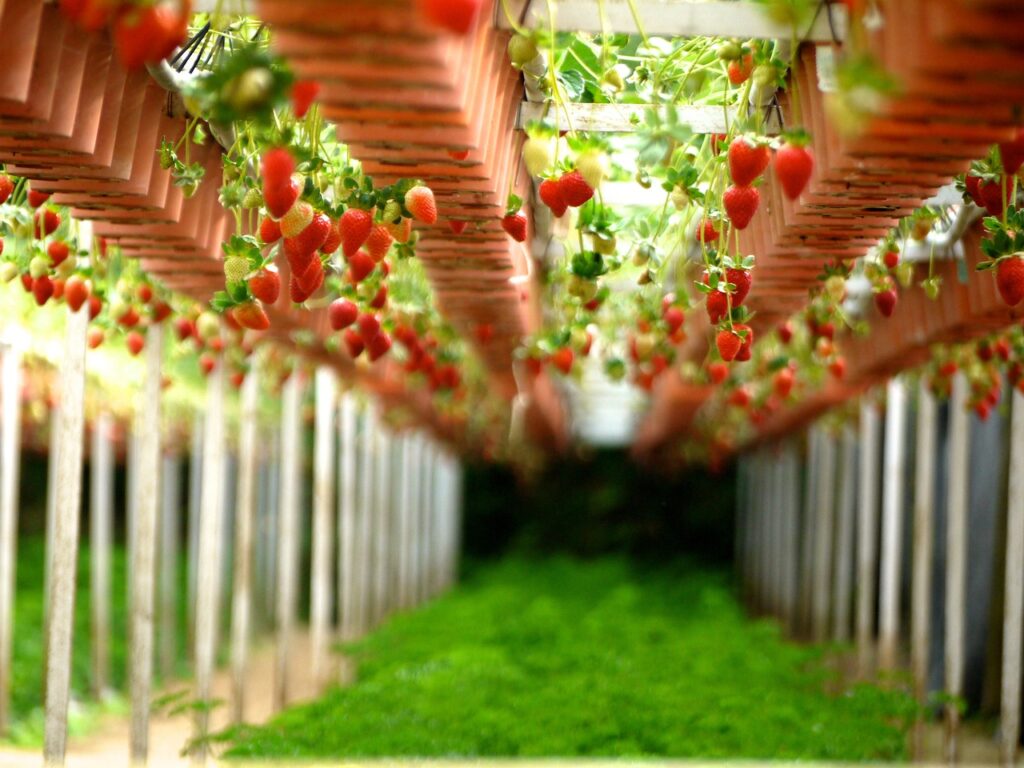Growing strawberries is a fun and rewarding gardening activity.
Here are some general steps you can follow to grow strawberries successfully:
Choose the right variety:
There are many different varieties of strawberries to choose from.
Make sure to select a variety that is suitable for your climate and soil type.
Pick a suitable location:
Strawberries need full sun (at least 6 hours of direct sunlight per day) and well-drained soil.
Choose a location that gets plenty of sunlight and has good drainage.
Prepare the soil:
Before planting, put some compost or aged manure into the soil to improve its texture and fertility.
Plant the strawberries:
Plant strawberries in the early spring, as soon as the ground can be worked.
Set the plants about 18 inches apart in rows that are spaced about 3 feet apart.
Make sure the crown (the point where the roots meet the stem) is level with the soil surface.
Water the plants:
Keep the soil moist, but not waterlogged. Strawberries need regular watering, especially during hot, dry weather.
Fertilize the plants:
Fertilize the strawberries with a balanced fertilizer, such as a 10-10-10, once a month during the growing season.
Control weeds:
Weeds can compete with strawberries for water and nutrients.
Keep the area around the plants weed-free by pulling them by hand or using mulch.
Protect the plants:
Cover the plants with a floating row cover to protect them from pests and cold temperatures.
Harvest the strawberries:
Pick the strawberries as soon as they are ripe, which is usually when they turn red.
To avoid damaging the plant, pick the berries by pinching them off at the stem.
There are several growing problems that are specific to strawberry plants:
Soil-borne diseases:
Strawberry plants are susceptible to several soil-borne diseases, including Verticillium wilt, Fusarium wilt, and Phytophthora crown rot.
These diseases can cause stunted growth, yellowing of leaves, and wilting of the plant.
Pests:
Strawberry plants are also vulnerable to a range of pests, including aphids, spider mites, slugs, and snails.
These pests can damage the leaves and fruit of the plant, leading to reduced yields.
Nutrient deficiencies:
Strawberry plants require specific nutrients, such as nitrogen, phosphorus, and potassium, to grow and produce fruit.
If these nutrients are not available in the soil or are not properly balanced, the plants may suffer from stunted growth, yellowing of leaves, and reduced fruit production.
Watering issues:
Strawberry plants require regular watering, but overwatering or underwatering can cause problems. Overwatering can lead to root rot, while underwatering can cause the fruit to become dry and small.
Temperature sensitivity:
Strawberry plants are sensitive to both high and low temperatures.
High temperatures can cause the fruit to become soft and mushy, while low temperatures can cause the leaves to turn yellow and drop off the plant.
Crowding:
Strawberry plants should be spaced properly to allow for good air circulation and to prevent the spread of diseases.
If plants are crowded together, they may compete for nutrients and light, leading to reduced yields and increased susceptibility to pests and diseases.
You might also like these articles:
- A Comprehensive Guide to Caterpillar Pest Control
- A Plant’s Nutritional Needs: The Best Fertilizer for Each Stage of Plant Growth
- Bacterial leaf spot treatment
- Beneficial insectaries
- Best insecticides for vegetables garden
- Combatting Thrips: Effective Strategies for Eliminating and Controlling Pest Infestations
- Desert Wonders: Cultivating Beautiful Cactuses
- Effective Control Methods for Japanese Beetles and Grubs in Your Garden
- Effective Ways to Control Leaf Miners: Chemical, Organic, and Biological Treatments
- Fusarium wilt treatment
- Getting rid of mealy bugs
- Growing Corn: Tips for Choosing the Right Variety and Achieving Healthy Growth














